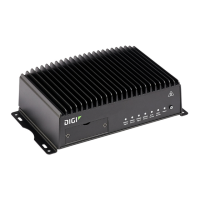IPv6 Configure a WAN for IPv6
Digi TransPort WR Routers User Guide
71
Configure a WAN for IPv6
Configuring a WANfor IPv6 involves these tasks:
n Enable IPv6 on a WAN
n Configure prefix delegation on a WAN
Enable IPv6 on a WAN
You can enable IPv6 on a per-WAN basis.
For IPv6 to work on a WAN interface, the ISP to which the WAN interface is connected must support
IPv6.
Web
1. From the menu, click Network > Networks > WANs. The WANs page appears.
2. Select the WAN on which you want to enable IPv6.
3. Open the IPv6 group, and enable IPv6.
Command line
To enable IPv6 on a WAN interface, use the wan command ipv6-state parameter. For example:
digi.router> wan 1 ipv6-state on
digi.router> save config
Configure prefix delegation on a WAN
When the WAN interface gets an IPv6 address, the TransPort device automatically sends a prefix
delegation request to the ISP. By default, the TransPort device requests a /60 prefix, which allows the
device to support up to 15 LANs. The number of LANs that can be supported is equal to 2 raised to the
power of ((64 - prefix-length) - 1). You can request a different prefix length from this default.
Note The TransPort is not guaranteed to receive a prefix of the requested length. For example, the
TransPort device may request a /60 prefix, but receive a /62 prefix. This means you might have more
LANs with IPv6 enabled than can be supported by the received prefix. In this case, the TransPort sets
the prefix on the first LAN interfaces as defined by the number of available LANs.
Web
1. From the menu, click Network > Networks > WANs. The WANs page appears.
2. Select the WAN on which you want to configure prefix delegation.
3. Enter the length of the requested prefix in the Requested Prefix Length field.
Command line
To change the length of the requested prefix, use the wan command ipv6-prefix-length parameter.
For example:

